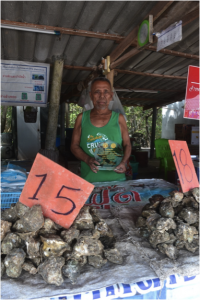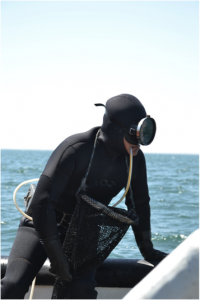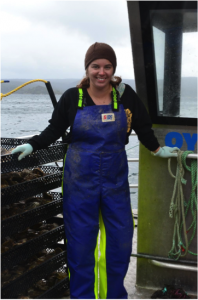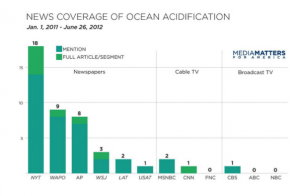An international journey to discover how OA will affect human communities uncovered the pressing need to build knowledge and capacity worldwide

An oyster farmer in Surat Thani shows off his prize for having the highest quality oysters in the region. He told me how changes in the water he didn’t understand were causing problems with his oysters. Lack of monitoring in the region and poor education among oyster farmers makes it difficult for them to understand and address ecological problems affecting their industry.
By Alexis Valauri-Orton – GOH staff member
When I left the United States in July 2012 to learn how coastal communities around the world might be affected by ocean acidification (OA), I did not expect the most common response to my questions to be, “Ocean acidification? Never heard of it.” From the oyster farmers of Surat Thani, Thailand to the Minister of Marine Resources in the Cook Islands almost nobody has heard of OA, the alarmingly rapid decrease of oceanic pH and changes to carbonate chemistry due to CO2 pollution. OA poses serious threats to the economy and food security of many coastal communities. How have we failed to spread the message to the communities that need it most?
For a full year, I traveled on a Thomas J. Watson Fellowship, studying human narratives of OA in Norway, Hong Kong, Thailand, New Zealand, the Cook Islands, and Peru. The Watson Fellowship allows 40 recent college graduates one year of independent, purposeful exploration outside of the United States so they may become more humane, effective participants in the world community. During that time, I interviewed, lived and worked with hundreds of members of marine-dependent communities, investigating how they valued resources threatened by OA. I chose these countries as a means to understand how varying levels of income, social services, and education can shape perceived and real vulnerabilities to OA. As a native of the Pacific Northwest, the ocean has always fascinated and inspired me, but when I became familiar with OA my fascination took on a sense of urgency. How will this problem affect our world and its inhabitants, how can we work together to address it, and why has no one heard of it?

A mussel farmer in The Marlborough Sounds of New Zealand adjusts fine netting that catches the natural stocks of mussel larvae floating in the water. In Washington, many bays can no longer rely upon natural sources of shellfish larvae and have turned to hatcheries instead.
In March I sat down with Bruce Hern, longtime shellfish farmer in the Marlborough Sounds of New Zealand, home to the famous green-lipped mussel. “Have people here been talking about ocean acidification?” I asked him. “No, not at all, not at all.” Three weeks earlier, when I attended the New Zealand Workshop on OA at Otago University, there was a whole lot of talk about it. But this information never made its way to the people who have the most at stake, and who were not included in the conversation.
In 2011, 323 articles about OA were published in scientific journals (revised from Gattuso and Hansson, 2011), but between January 2011 and June 2012 only 45 stories on ocean acidification appeared in popular print and televised news sources (Theel, Medial Matters, 2012). How many stories have been published in the local section of newspapers? How many in aquaculture and fishing newsletters? While academic publications provide excellent and necessary insights into the science of OA, they rarely reach the communities who will be affected by the issue and the stakeholders who can change its trajectory.
I asked each person I interviewed, “What do you want to know about ocean acidification?” The most common answer was, “I want to know how it will affect me and what I can do about it.” Coastal communities don’t just want to know a piece of the OA puzzle, they want to know the whole story and how they fit into it. Telling audiences about decreased calcification rates rewards me with blank stares, but telling the story of how the oyster industry in my home state has been affected by and responded to OA gives me a room bursting with raised hands and questions like, “How can I learn more about this? Who can I contact?”

A scallop diver in Sechura, Peru prepares to enter the water. He may spend up to six hours a day underwater, receiving oxygen through a narrow, free-flowing tube and shoveling scallops from the muddy bottom into the bag around his neck.
There are thousands of coastal communities whose entire economies rest upon vulnerable species such as scallops, oysters, and coral and these communities will be affected. Sechura, Peru, is built upon the scallop-farming industry. Divers and deckhands spend hours out on the water harvesting; hundreds of men and women work late into the night in processing plants; entire fleets of self-employed taxi drivers shuttle workers from the town to the docks; and stall owners in the local market told me “If there are no scallops in Sechura, there is nothing.”
If communities like Sechura understand what they’re up against, they will be in a far better position to adapt to changing conditions and protect their livelihoods. The fishermen I met this year all wanted to know, “What is the story of ocean acidification, and how do I fit in?” By meeting communities where they are and telling stories that empower them with relevant, applicable knowledge, we can help coastal communities prepare for OA. Telling good stories also requires having good information, so it remains crucial that we continue to invest in research.

Alexis Valauri-Orton, the author, working on an oyster boat in Stewart Island, New Zealand.
Global Ocean Health (GOH) and our partner organizations are working to secure funding for science that will help us answer important questions, questions that marine-dependent communities need answers to. In order for our research investments to reach their potential, however, we must take them one step further. That’s where GOH comes in. I started working with GOH about a month ago, and I have been blown away by how the organization is tackling the very issues I encountered during my fellowship year. GOH works with waterfront communities to help them monitor and adapt to ocean acidification and become their own advocates for preserving ocean health in the face of OA.
In New Zealand, as illustrated by my conversation with Bruce Hern, past work on ocean acidification has failed to engage the industry. GOH saw this problem from the other side of the globe and organized a workshop in New Zealand in December of 2013 called “Future proofing New Zealand’s shellfish aquaculture: monitoring and adaptation to ocean acidification.” In partnership with the Marine Conservation Institute, GOH brought government, industry and science stakeholders together to hear from members of the US shellfish farming industry, the experts from the frontlines of OA. The ball is officially rolling in New Zealand, and I have a feeling that if I go back to talk to Bruce Hern this year, we will have a very different conversation, one about a shellfish industry engaged and interested in adapting to ocean acidification. This is the conversation we need to be having around the world, and GOH is actively engaged in it.

